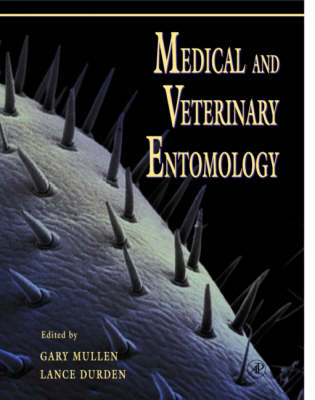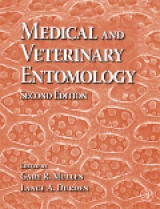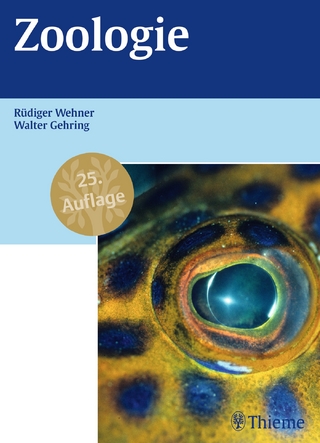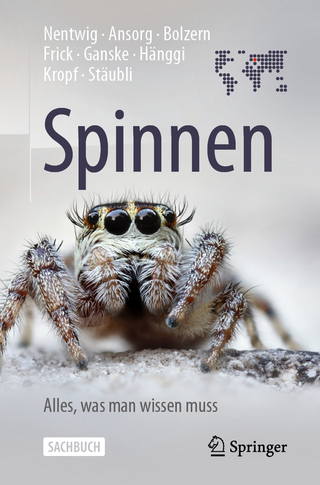
Medical and Veterinary Entomology
Academic Press Inc (Verlag)
978-0-12-510451-7 (ISBN)
- Titel erscheint in neuer Auflage
- Artikel merken
Medical and Veterinary Entomology is a comprehensive text and is primarily intended for graduate students and upper level undergraduates studying the medical and veterinary significance of insects and related arthropods. The book will also appeal to a larger audience, specialists and non-specialists alike, including entomologists, parasitologists, biologists, epidemiologists, physicians, public health personnel, veterinarians, wildlife specialists and others looking for a readable, authoritative book on this topic. The first two chapters provide overviews of medical-veterinary entomology and epidemiology, respectively. These are followed by individual chapters devoted to each group of insects or arachnids of medical-veterinary importance and the health problems they can cause including their role as vectors of pathogens. Each of these chapters provides an overview of the taxonomy, biology and ecology of the group, and is followed by separate sections on their medical and veterinary importance, then by a section on prevention and control and, finally, by a list of references and further reading.
Gary Mullen is Professor of Entomology emeritus in the Department of Entomology and Plant Pathology at Auburn University, AL, USA. He earned his M.S. and Ph.D. degrees in entomology at Cornell University before serving as medical entomologist and administrator of the Pennsylvania Vector Control Program, Allegheny County Health Department, Pittsburgh, PA. He joined the faculty of Auburn University in 1975 as a medical-veterinary entomologist, acarologist, and aquatic ecologist, teaching courses and conducting research at Auburn for 34 years. His major areas of research have focused on biting flies, notably mosquitoes and biting midges, and ticks as vectors of animal pathogens Lance Durden is Professor of Vector Ecology and Curator of the Insect Collection in the Department of Biology at Georgia Southern University, Statesboro, USA. He earned a Ph.D. in Zoology from the University of London, UK and has worked at Vanderbilt School of Medicine in Nashville, Tennessee, the Smithsonian Institution in Washington DC, Auburn University in Alabama, and the U.S. Army Medical Research Institute of Infectious Diseases (USAMRIID) in Frederick, Maryland. He is the author or co-author of approximately 300 peer-reviewed publications including 24 book chapters and 7 books or monographs. His research focuses on ectoparasitic arthropods and vector-borne diseases.
Contributors
Preface
Acknowledgments
Chapter 1. Introduction
General Entomology
Medical-Veterinary Entomology Literature
History of Medical-Veterinary Entomology
Identification and Systematics of Arthropods of Medical-Veterinary Importance
Types of Problems Caused by Arthropods
Arthropod-Borne Diseases
Food Contaminants
Fear of Arthropods
Delusory Parasitosis
Toxins and Venoms
Host Defenses
Forensic Entomology
Minor Arthropod Problems of Medical-Veterinary Interest
References and Further Reading
Chapter 2. Epidemiology of Vector-Borne Diseases
Components of Transmission Cycles
Modes of Transmission
Transmission Cycles
Interseasonal Maintenance
Vector Incrimination
Surveillance
References and Further Reading
Chapter 3. Cockroaches (Blattaria)
Taxonomy
Morphology
Life History
Behavior and Ecology
Common Cockroach Species
Public Health Importance
Veterinary Importance
Prevention and Control
References and Further Reading
Chapter 4. Lice (Phthiraptera)
Taxonomy
Morphology
Life History
Behavior and Ecology
Lice of Medical Interest
Lice of Veterinary Interest
Public Health Importance
Veterinary Importance
Prevention and Control
References and Further Reading
Chapter 5. True Bugs (Hemiptera)
Kissing Bugs (Reduviidae)
Taxonomy
Morphology
Life History
Behavior and Ecology
Public Health Importance
Veterinary Importance
Prevention and Control
Bed Bugs (Cimicidae)
Taxonomy
Morphology
Life History
Behavior and Ecology
Public Health Importance
Veterinary Importance
Prevention and Control
References and Further Reading
Chapter 6. Beetles (Coleoptera)
Taxonomy
Morphology
Life History
Behavior and Ecology
Public Health Importance
Veterinary Importance
Prevention and Control
References and Further Reading
Chapter 7. Fleas (Siphonaptera)
Taxonomy
Morphology
Life History
Behavior and Ecology
Fleas of Medical-Veterinary Importance
Public Health Importance
Veterinary Importance
Prevention and Control
References and Further Reading
Chapter 8. Flies (Diptera)
Taxonomy
Morphology
Life History
Behavior and Ecology
Families of Minor Medical or Veterinary Interest
Public Health Importance
Veterinary Importance
Prevention and Control
References and Further Reading
Chapter 9. Moth Flies and Sand Flies (Psychodidae)
Taxonomy
Morphology
Life History
Behavior and Ecology
Public Health Importance
Veterinary Importance
Prevention and Control
References and Further Reading
Chapter 10. Biting Midges (Ceratopogonidae)
Taxonomy
Morphology
Life History
Behavior and Ecology
Public Health Importance
Veterinary Importance
Prevention and Control
References and Further Reading
Chapter 11. Black Flies (Simuliidae)
Taxonomy
Morphology
Life History
Behavior and Ecology
Public Health Importance
Veterinary Importance
Prevention and Control
References and Further Reading
Chapter 12. Mosquitoes (Culicidae)
Taxonomy
Morphology
Life History
Behavior and Ecology
Public Health Importance
Veterinary Importance
Prevention and Control
References and Further Reading
Chapter 13. Horse Flies and Deer Flies (Tabanidae)
Taxonomy
Morphology
Life History
Behavior and Ecology
Public Health Importance
Veterinary Importance
Prevention and Control
References and Further Reading
Chapter 14. Muscid Flies (Muscidae)
Taxonomy
Morphology
Life History
Behavior and Ecology
Species of Medical-Veterinary Importance
Public Health Importance
Veterinary Importance
Prevention and Control
References and Further Reading
Chapter 15. Tsetse Flies (Glossinidae)
Taxonomy
Morphology
Life History
Behavior and Ecology
Public Health Importance
Veterinary Importance
Prevention and Control
References and Further Reading
Chapter 16. Myiasis (Muscoidea, Oestroidea)
Taxonomy
Morphology
Life History
Ecology and Behavior
Flies Involved in Myiasis
Public Health Importance
Veterinary Importance
Prevention and Control
References and Further Reading
Chapter 17. Louse Flies, Reds, and Related Flies (Hippoboscoidea)
Taxonomy
Morphology
Life History
Behavior and Ecology
Common Species of Hippoboscids
Public Health Importance
Veterinary Importance
Prevention and Control
References and Further Reading
Chapter 18. Moths and Butterflies (Lepidoptera)
Taxonomy
Morphology
Life History
Behavior and Ecology
Public Health Importance
Veterinary Importance
Prevention and Control
References and Further Reading
Chapter 19. Ants, Wasps,and Bees (Hymenoptera)
Taxonomy
Morphology
Life History
Behavior and Ecology
Hymenoptera Venoms
Ants
Wasps and Hornets
Bees
Public Health Importance
Veterinary Importance
Prevention and Control
References and Further Reading
Chapter 20. Scorpions (Scorpiones)
Taxonomy
Morphology
Life History
Behavior and Ecology
Public Health Importance
Veterinary Importance
Prevention and Control
References and Further Reading
Chapter 21. Solpugids (Solifugae)
References and Further Reading
Chapter 22. Spiders (Araneae)
Taxonomy
Morphology
Life History
Behavior and Ecology
Public Health Importance
Veterinary Importance
Prevention and Control
References and Further Reading
Chapter 23. Mites (Acari)
Taxonomy
Morphology
Life History
Behavior and Ecology
Public Health Importance
Mite-Borne Diseases of Humans
Veterinary Importance
References and Further Reading
Chapter 24. Ticks (Ixodida)
Taxonomy
Morphology
Life History
Behavior and Ecology
Tick Species of Medical-Veterinary Importance
Public Health Importance
Veterinary Importance
Prevention and Control
References and Further Reading
Taxonomic Index
Subject Index
| Erscheint lt. Verlag | 27.9.2002 |
|---|---|
| Verlagsort | San Diego |
| Sprache | englisch |
| Maße | 216 x 279 mm |
| Gewicht | 1846 g |
| Themenwelt | Medizin / Pharmazie ► Medizinische Fachgebiete |
| Naturwissenschaften ► Biologie ► Zoologie | |
| Veterinärmedizin | |
| ISBN-10 | 0-12-510451-0 / 0125104510 |
| ISBN-13 | 978-0-12-510451-7 / 9780125104517 |
| Zustand | Neuware |
| Haben Sie eine Frage zum Produkt? |
aus dem Bereich



